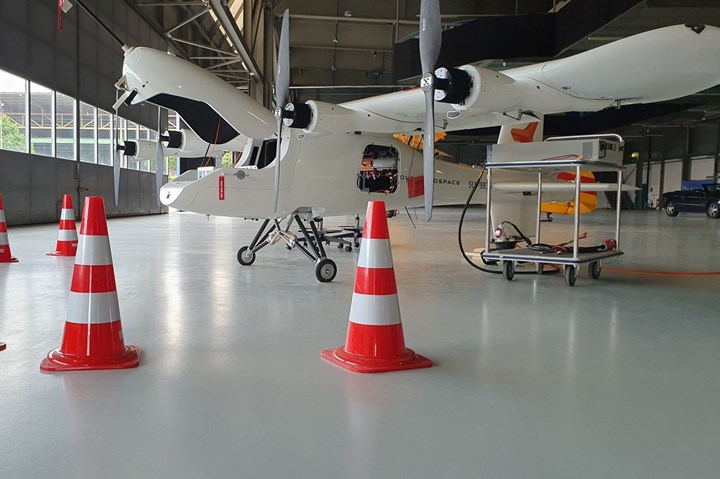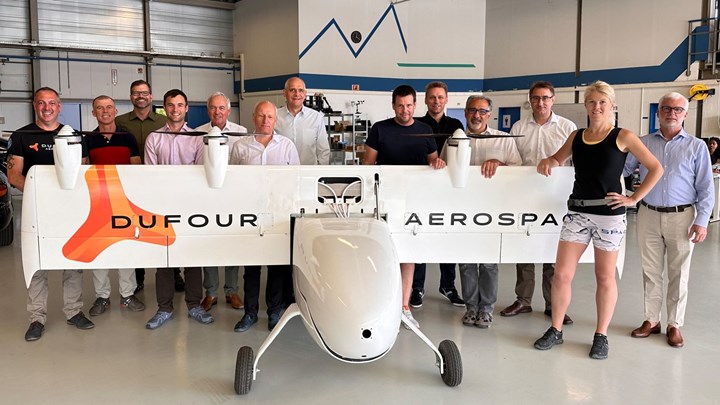Dufour Aerospace announces composites airframe, nacelle and tail suppliers for Aero2 drone prototype
The uncrewed, hybrid-electric, tilt-wing cargo transport aircraft will feature an all-composite airframe and composites-intensive nacelle and tail.

Photo Credit, all images: Dufour Aerospace
This summer, electric vertical takeoff and landing (eVTOL) company (Zurich, Switzerland) for its uncrewed, hybrid-electric, tilt-wing Aero2 drone, as well as the selection of key suppliers (Ennetbürgen, Switzerland) for the composite airframe and (Horw, Switzerland) for composite structural components in the nacelles and tail.
Since its original prototype, the design for Aero2 has evolved from a conventional tail to an H-tail with a larger fuselage and wingspan and a wing profile optimized for its likely missions, such as critical goods transport, aerial surveying beyond visual line of sight (BVLOS) and public safety applications.
The Aero2 aircraft is expected to be able to transport 40 kilograms over a distance of 400 kilometers. It will serve as a precursor to the Aero3, a larger tilt-wing aircraft which could support options for uncrewed or crewed operations.
The release of final production specifications follows successive recent announcements from Dufour Aerospace. In May, the company announced it had been selected for a grant of CHF 2.5 million ($2.8 million) from Innosuisse, the innovation agency of the Swiss Confederation. In January, the company closed a Series B financing round led by Vista Global. In late 2022, Dufour announced the largest civilian drone purchase in U.S. history, made with Spright, the drone division of Air Methods. Spright will purchase 40 Aero2 with options for an additional 100 units.
Dufour Aerospace is now ordering materials required to build X2.3, the last Aero2 prototype before the entry-into-service aircraft. X2.3 will be able to demonstrate the full flight envelope and the performance of the hybrid system. Flight testing of X2.3 is expected to start early in 2024. The start of series production of Aero2 is planned for 2025.
All-composite airframe, produced by Connova AG
According to Dufour Aerospace, the all-composite lightweight airframe is a key contributor to the Aero2’s performance. Connova AG will produce the major subassemblies for the Aero2 airframe main wing, fuselage and engine bay at its production site in Villmergen, Switzerland.
“Connova has a wealth of experience and knowledge as an established composite manufacturer to the aerospace and automotive industry. In making the wings for Dufour’s current Aero2 experimental flight test aircraft to a new patent-pending design and manufacturing method, Connova has demonstrated the diligence and professionalism required to assure the high standards of quality necessary to deliver light weight aircraft structures,” says Simon Bendrey, head of design at Dufour Aerospace.
“We strongly believe in the success of the aircraft and are willing to increase our production capacities with the growing demand by Dufour Aerospace in the upcoming years,” says Taylan Toprak, head of sales and project management at Connova.
Composite nacelle and tail components, produced by Aerolite AG
For the first phase of Dufour Aerospace’s collaboration with Aerolite AG, Aerolite will produce and delivery the nacelle and tail structure components for the Aero2 prototype aircraft. The company is also being considered for production of the subsequent serial aircraft.
According to Dufour Aerospace, weight reduction is one of the keys to success for aviation engineering, and Aerolite was selected for its years of experience producing solid yet lightweight solutions as a supplier to the aviation industry.
Related Content
Combining multifunctional thermoplastic composites, additive manufacturing for next-gen airframe structures
The DOMMINIO project combines AFP with 3D printed gyroid cores, embedded SHM sensors and smart materials for induction-driven disassembly of parts at end of life.
Read MoreWelding is not bonding
Discussion of the issues in our understanding of thermoplastic composite welded structures and certification of the latest materials and welding technologies for future airframes.
Read MoreDevelopment of a composite liquid hydrogen tank for commercial aircraft
Netherlands consortium advances cryogenic composites testing, tank designs and manufacturing including AFP, hybrid winding, welding of tank components and integrated SHM and H2 sensors for demonstrators in 2025.
Read MoreLow-cost, efficient CFRP anisogrid lattice structures
CIRA uses patented parallel winding, dry fiber, silicone tooling and resin infusion to cut labor for lightweight, heavily loaded space applications.
Read MoreRead Next
Next-gen fan blades: Hybrid twin RTM, printed sensors, laser shock disassembly
MORPHO project demonstrates blade with 20% faster RTM cure cycle, uses AI-based monitoring for improved maintenance/life cycle management and proves laser shock disassembly for recycling.
Read MoreUltrasonic welding for in-space manufacturing of CFRTP
Agile Ultrasonics and NASA trial robotic-compatible carbon fiber-reinforced thermoplastic ultrasonic welding technology for space structures.
Read MoreScaling up, optimizing the flax fiber composite camper
Greenlander’s Sherpa RV cab, which is largely constructed from flax fiber/bio-epoxy sandwich panels, nears commercial production readiness and next-generation scale-up.
Read More.jpg;width=70;height=70;mode=crop)













